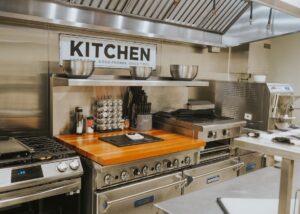Designing Your Kitchen for Culinary Mastery


A well-designed kitchen is more than just a place to cook; it’s the heart of your home and the foundation for culinary creativity. Whether you are an aspiring chef or a passionate home cook, creating a kitchen that supports both functionality and style can transform your cooking experience. By considering workflow, storage, lighting, and appliances, you can design a space that encourages efficiency, reduces stress, and sparks inspiration every time you step inside.
Understanding the Workflow
The first step in designing a kitchen for culinary excellence is understanding your workflow. The “kitchen work triangle”—the relationship between the stove, sink, and refrigerator—remains a fundamental concept in efficient kitchen design. Positioning these key areas strategically reduces unnecessary movement and ensures that you can cook comfortably, even during complex meal preparations.
Beyond the work triangle, consider how you move within the space. For instance, placing frequently used utensils, cutting boards, and pots near the stove minimizes interruptions. Similarly, ensure prep areas are adjacent to storage for ingredients, making it easy to gather what you need without breaking your rhythm. By mapping out your workflow in advance, you can identify potential bottlenecks and design a kitchen that supports smooth, uninterrupted cooking.
Optimizing Storage
Storage is a crucial element for both efficiency and aesthetics in a kitchen. Deep cabinets, pull-out shelves, and dedicated pantry spaces help keep ingredients and cookware organized and easily accessible. Investing in quality storage solutions enables you to maintain a clutter-free environment, which is crucial for a seamless cooking process.
Consider vertical storage as well. Wall-mounted racks, magnetic knife strips, and open shelving provide both functionality and visual interest. They make items easy to reach while adding character to your kitchen. Custom cabinetry with built-in organizers for spices, utensils, and pots ensures that everything has a designated place, reducing the time spent searching for what you need. An organized kitchen is not only visually appealing but also promotes efficiency, allowing you to focus on the art of cooking.
Choosing the Right Appliances
High-quality appliances are the backbone of a kitchen designed for culinary excellence. While style matters, functionality should guide your choices. A reliable stove with even heat distribution, a powerful oven, and a versatile refrigerator can dramatically improve your cooking outcomes. Modern appliances with innovative features can save time and enhance precision, whether you are baking, roasting, or fermenting.
Consider your specific cooking habits when selecting appliances. If you love baking, a double oven or a professional-grade mixer might be indispensable. For those who frequently entertain, a spacious refrigerator and a quiet dishwasher become invaluable. Appliances should complement your workflow and elevate your cooking, not hinder it. By investing wisely, you create a kitchen that supports your culinary ambitions.
Prioritizing Lighting
Lighting plays a pivotal role in both functionality and ambiance. Proper task lighting ensures that food preparation is safe and efficient. Under-cabinet lighting, adjustable overhead lights, and strategically placed pendant fixtures illuminate your workspace, reducing eye strain and fatigue. Meanwhile, ambient lighting creates a welcoming atmosphere, transforming your kitchen into a place where cooking feels enjoyable rather than burdensome.
Natural light, if available, should be maximized. A window above the sink or a skylight can make the space feel open and inviting. Layered lighting that combines task, ambient, and accent lights enables you to adapt the environment to your needs, whether it’s a focused cooking session or a relaxed evening with family. Thoughtful lighting design enhances both the functionality and mood of your kitchen.
Selecting Durable and Stylish Materials
The surfaces and materials in your kitchen must strike a balance between durability and style. Countertops, flooring, and backsplashes are subject to heavy use, so investing in materials that can withstand heat, moisture, and wear is essential. Granite, quartz, and stainless steel are popular choices for their resilience and sleek appearance.
Cabinetry and flooring should also be chosen with care. Hardwood or engineered wood provides warmth and elegance, while tile or stone flooring offers long-lasting durability and a classic look. Combining practical materials with aesthetic appeal ensures your kitchen remains both functional and visually striking for years to come.
Creating Zones for Efficiency
Dividing your kitchen into zones can significantly enhance its functionality. Typical zones include prep, cooking, cleaning, and storage. Each zone should contain all the necessary components to perform its specific tasks. For instance, the prep zone should consist of cutting boards, knives, mixing bowls, and measuring tools, while the cooking zone houses pots, pans, and utensils.
This zoning strategy minimizes cross-traffic, prevents clutter, and helps maintain a clean and organized space. When every item has its place and each task has its dedicated area, cooking becomes more efficient, and the kitchen feels less chaotic.
Infusing Personal Style
Finally, a kitchen designed for culinary excellence should reflect your personal style. Color schemes, finishes, and decorative elements can enhance the space and make it uniquely yours. From bold backsplashes to elegant countertops, the aesthetic choices you make contribute to a kitchen environment that inspires creativity and joy.
Adding personal touches, such as artwork, plants, or stylish storage containers, can also make your kitchen more inviting. When your space feels inspiring, cooking transforms from a chore into a pleasurable and rewarding experience.
Designing a kitchen for culinary excellence requires careful consideration of workflow, storage, appliances, lighting, materials, and personal style. By prioritizing efficiency and functionality without sacrificing aesthetics, you can create a space that enhances every aspect of cooking. A thoughtfully designed kitchen allows you to work seamlessly, experiment confidently, and enjoy the process of preparing meals. Ultimately, a kitchen tailored to your needs becomes more than just a room; it becomes a place where culinary creativity thrives.
